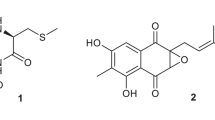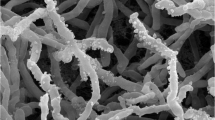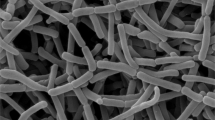Abstract
Two novel Gram-stain-positive actinobacteria, designated H23-8T and H23-19, were isolated from a sea sediment sample and their taxonomic positions were investigated by a polyphasic approach. Phylogenetic analysis based on 16S rRNA gene sequence comparisons showed that these isolates were closely related to the members of the genus Agromyces, with similarity range of 94.5–97.4%. Strains H23-8T and H23-19 contained L-2,4-diaminobutyric acid, D-alanine, D-glutamic acid and glycine in their peptidoglycan. The predominant menaquinones were MK-13 and MK-12, and the major fatty acids were anteiso-C15:0, anteiso-C17:0 and iso-C16:0. The DNA G+C content was 72.3–72.5 mol%. The chemotaxonomic characteristics of the isolates matched those described for members of the genus Agromyces. The results of phylogenetic analysis and DNA–DNA hybridization, along with differences in phenotypic characteristics between strains H23-8T and H23-19 and the species of the genus Agromyces with validly published names, indicated that the two isolates should be assigned to a novel species of the genus Agromyces, for which the name Agromyces marinus sp. nov. is proposed; the type strain is H23-8T (=NBRC 109019T=DSM 26151T).
Similar content being viewed by others
Log in or create a free account to read this content
Gain free access to this article, as well as selected content from this journal and more on nature.com
or
References
Gledhill, W. E. & Casida, L. E. Predominant catalase-negative soil bacteria. III. Agromyces, gen. n., microorganisms intermediary to Actinomyces and Nocardia. Appl. Microbiol. 18, 340–349 (1969).
Zgurskaya, H. I. et al. Emended description of the genus Agromyces and description of Agromyces cerinus subsp. cerinus sp. nov., subsp. nov., Agromyces cerinus subsp. nitratus sp. nov., subsp. nov., Agromyces fucosus subsp. fucosus sp. nov., subsp. nov., and Agromyces fucosus subsp. hippuratus sp. nov., subsp. nov. Int. J. Syst. Evol. Microbiol. 42, 635–641 (1992).
Akimov, V. N. & Evtushenko, L. I. Genus IV. Agromyces in Bergey’s Manual of Systematic Bacteriology 2nd edn Vol. 5 eds Goodfellow M., et al.) 862–876 Springer: New York, (2012).
De Maria, S. et al. Interactions between accumulation of trace elements and macronutrients in Salix caprea after inoculation with rhizosphere microorganisms. Chemosphere 84, 1256–1261 (2011).
Trifonova, R., Postma, J. & van Elsas, J. D. Interactions of plant-benefical bacteria with the ascomycete Coniochaeta ligniaria. J. Appl. Microbiol. 106, 1859–1866 (2009).
Zakhia, F. et al. Diverse bacteria associated with root nodules of spontaneous legumes in Tunisia and first report for nifH-like gene within the genera Microbacterium and Starkeya. Microb. Ecol. 51, 375–393 (2006).
Dastager, S. G. & Damare, S. Marine actinobacteria showing phosphate-solubilizing efficiency in Chorao Island, Goa, India. Curr. Microbiol. 66, 421–427 (2013).
Beleneva, I. A. & Zhukova, N. V. Bacterial communities of brown and red algae from Peter the Great Bay, the Sea of Japan. Mikrobiologiia 75, 410–419 (2006).
Blunt, J. W. et al. Marine natural products. Nat. Prod. Rep. 24, 31–86 (2007).
Lam, K. S. Discovery of novel metabolites from marine actinomycetes. Curr. Opin. Microbiol. 9, 245–251 (2006).
Hamada, M. et al. Luteimicrobium album sp. nov., a novel actinobacterium isolated from a lichen collected in Japan, and emended description of the genus Luteimicrobium. J. Antibiot. 65, 427–431 (2012).
Kim, O. S. et al. Introducing EzTaxon-e: a prokaryotic 16S rRNA gene sequences database with phylotypes that represent uncultured species. Int. J. Syst. Evol. Microbiol. 62, 716–721 (2012).
Thompson, J. D., Gibson, T. J., Plewniak, F., Jeanmougin, F. & Higgins, D. G. The CLUSTAL_X windows interface: flexible strategies for multiple sequence alignment aided by quality analysis tools. Nucleic Acids Res. 25, 4876–4882 (1997).
Saitou, N. & Nei, M. The neighbor-joining method: a new method for reconstructing phylogenetic trees. Mol. Biol. Evol. 4, 406–425 (1987).
Felsenstein, J. Evolutionary trees from DNA sequences: a maximum likelihood approach. J. Mol. Evol. 17, 368–376 (1981).
Fitch, W. M. Toward defining the course of evolution: minimum change for a specific tree topology. Syst. Zool. 20, 406–416 (1971).
Tamura, K. et al. MEGA5: molecular evolutionary genetics analysis using maximum likelihood, evolutionary distance, and maximum parsimony methods. Mol. Biol. Evol. 28, 2731–2739 (2011).
Felsenstein, J. Confidence limits on phylogenies: an approach using the bootstrap. Evolution 39, 738–791 (1985).
Saito, H. & Miura, K. Preparation of transforming deoxyribonucleic acid by phenol treatment. Biochim. Biophys. Acta 72, 619–629 (1963).
Tamaoka, J. & Komagata, K. Determination of DNA base composition by reversed-phase high-performance liquid chromatography. FEMS Microbiol. Lett. 25, 125–128 (1984).
Ezaki, T., Hashimoto, Y. & Yabuuchi, E. Fluorometric deoxyribonucleic acid-deoxyribonucleic acid hybridization in microdilution wells as an alternative to membrane filter hybridization in which radioisotopes are used to determine genetic relatedness among bacterial strains. Int. J. Syst. Bacteriol. 39, 224–229 (1989).
Uchida, K., Kudo, T., Suzuki, K. & Nakase, T. A new rapid method of glycolate test by diethyl ether extraction, which is applicable to a small amount of bacterial cells of less than one milligram. J. Gen. Appl. Microbiol. 45, 49–56 (1999).
Sasser, M. Identification of bacteria by gas chromatography of cellular fatty acids, MIDI Technical Note 101. MIDI Inc. (Newark, Delaware (1990).
Hamada, M. et al. Mobilicoccus pelagius gen. nov., sp. nov and Piscicoccus intestinalis gen.nov., sp. nov., two new members of the family Dermatophilaceae, and reclassification of Dermatophilus chelonae (Masters et al. 1995) as Austwickia chelonae gen. nov., comb. nov. J. Gen. Appl. Microbiol. 56, 427–436 (2010).
Schleifer, K. H. & Kandler, O. Peptidoglycan types of bacterial cell walls and their taxonomic implications. Bacteriol. Rev. 36, 407–477 (1972).
Sasaki, J., Chijimatsu, M. & Suzuki, K. Taxonomic significance of 2,4-diaminobutyric acid isomers in the cell wall peptidoglycan of actinomycetes and reclassification of Clavibacter toxicus as Rathayibacter toxicus comb. nov. Int. J. Syst. Bacteriol. 48, 403–410 (1998).
Yoon, J. H., Schumann, P., Kang, S. J., Park, S. & Oh, T. K. Agromyces terreus sp. nov., isolated from soil. Int. J. Syst. Evol. Microbiol. 58, 1308–1312 (2008).
Thawai, C., Tanasupawat, S., Suwanborirux, K. & Kudo, T. Agromyces tropicus sp. nov., isolated from soil. Int. J. Syst. Evol. Microbiol. 61, 605–609 (2011).
Author information
Authors and Affiliations
Corresponding author
Rights and permissions
About this article
Cite this article
Hamada, M., Shibata, C., Tamura, T. et al. Agromyces marinus sp. nov., a novel actinobacterium isolated from sea sediment. J Antibiot 67, 703–706 (2014). https://doi.org/10.1038/ja.2014.60
Received:
Revised:
Accepted:
Published:
Issue date:
DOI: https://doi.org/10.1038/ja.2014.60
This article is cited by
-
Uncovering the biodiversity and biosynthetic potentials of rare actinomycetes
Future Journal of Pharmaceutical Sciences (2022)
-
Agromyces mangrovi sp. nov., a Novel Actinobacterium Isolated from Mangrove Soil
Current Microbiology (2018)
-
Intertidal marine sediment harbours Actinobacteria with promising bioactive and biosynthetic potential
Scientific Reports (2017)



